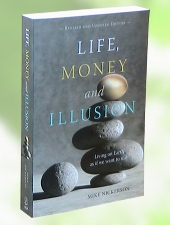The whole story:

Life, Money
and Illusion
The Invisible Hand
The "invisible hand" of the market is a famous analogy much used by the proponents of economic expansion. It is explained below.
Modern economic theory dates back to 1776 and the publication of Adam Smith's book The Wealth of Nations. In his brilliant analysis of the economic interactions between people, classes and nations, Smith introduced the image of the "invisible hand" - now one of the most influential metaphors of economic thought. The idea is that when each individual pursues his or her own advantage, he or she is "led by an invisible hand to promote an end which was no part of his intention," thereby doing more for society than if he or she had deliberately set out to do so.
In 1776 when Smith's book was first published, there was little people could do to enrich themselves without providing goods or services of use to others. It follows that, in the process of enriching themselves, they improved the opportunities available in society. Times have changed, however.
As advertising techniques evolved, it became questionable whether some goods and services actually enriched society in return for the wealth gained by promoters. With sufficient persuasion, people part with their money in exchange for illusions associated with material objects. Still, illusions have some value.
Of greater concern are the enormous fortunes being made buying and selling financial instruments: stocks, bonds, options, different types of money and the like. This route to personal fortune has even less justification as service to society.
Originally stock markets provided a source of capital to finance enterprises which served people. To the extent that this is still the case, they have their place.
However, financial markets have taken on a life of their own. Huge investments are made, not to make money by producing goods, but to make money through speculation alone. This sort of trading has reached a magnitude estimated to be 50 to 100 times greater than all trade in goods and services.
In currency trading, fortunes are made from tiny fluctuations in value. Exchange rates are monitored by computers which notify traders of profitable opportunities. Rather than providing a just return to investors for services rendered, this process siphons money out of societies. If we were able to trace the origins of the $600 billion which changes hands daily in financial trading, we would find money that otherwise would be funding schools, health care, artistic expression, international development and all manner of other civilized benefits.
The invisible hand once turned self-interest to the benefit of society. Today, the same impulse is pressing society and environment toward collapse. This massive indiscretion discredits the theory. The invisible hand can no longer excuse greed and inequity.
